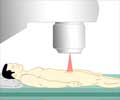
Hundreds of thousands of men die each year from prostate cancer. The standard procedure used worldwide for prostate cancer examinations starts with measurement of the PSA (prostate specific antigen) value in the blood. If this is high, physicians will usually remove samples of prostate tissue through the anus at six to sixteen points for pathological examination. However, 70% of the subjects show no signs of cancer.
So does this mean the high PSA level is a false alarm? Not always: the biopsies may have been taken at just the wrong places. Cancer is later found in 30% of the patients with negative results (no cancer). Among the positive results (patients with signs of cancer), doctors do not know the exact sizes of the tumor. In many cases, operations show that the tumors are so small that surgery was unnecessary. As well as that, the examination leads to inflammations in up to 5% of patients. Plus the fact that each examination costs around USD 2500 to carry out.
Source-Eurekalert



![Prostate Specific Antigen [PSA] & Prostate Cancer Diagnosis Prostate Specific Antigen [PSA] & Prostate Cancer Diagnosis](https://www.medindia.net/images/common/patientinfo/120_100/prostate-specific-antigen.jpg)









